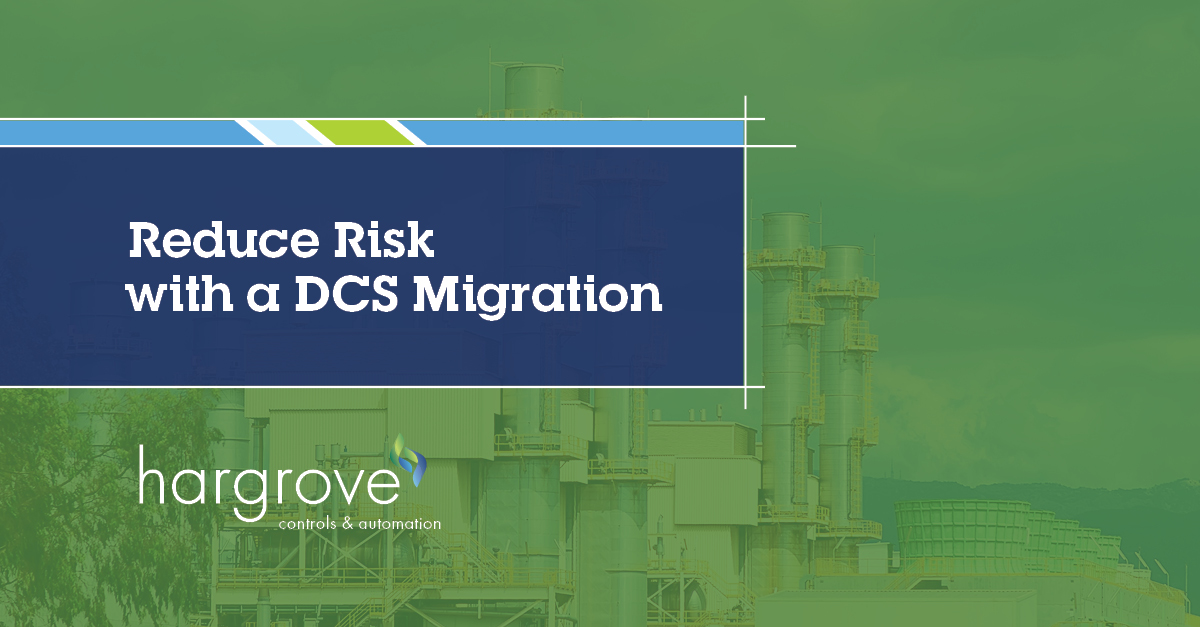Reduce Risk with a DCS Migration

Working at a manufacturing facility may often require scouring the web to purchase critical replacements or hardware for operating systems that are no longer readily available. If you are unable to locate a spare part, your facility could have unplanned downtime – resulting in lost production – until you can engineer a new solution.
Migrating from a legacy system to a modernized distributed control system (DCS) can support your facility long term, increase efficiency, and decrease unplanned downtime.
Risk Reduction with a DCS Migration
Your DCS is a critical asset within your industrial facility. It acts as the central nervous system of a process that connects everything and allows your facility to operate properly.
Some manufacturing plants have legacy systems that have been in service for 30 or more years. The older your equipment is, the increased likelihood of a failure. Parts can be harder to obtain, and vendor service and support will continue to diminish for legacy systems. With an older system, it can be increasingly difficult to find personnel who are able to program and support the system.
Delaying an upgrade can be risky. A DCS migration reduces unplanned downtime, addresses obsolescence issues and increases the availability of spare parts to support your systems. Modern systems are easier to program, troubleshoot, and support. They can more easily expand and add I/O. They also allow for advanced connectivity with the ability to integrate more systems and import more data into the DCS.
A DCS migration can also significantly improve your operator’s quality of life. The tools available in modern DCS systems include out-of-the-box alarm management, high performance HMI packages, and wireless infrastructure that can allow your facility to leverage devices in the field. Older systems tend to have overwhelming HMI graphics with too many colors, constant alarms, and calls for attention. Too much noise creates unnecessary distractions and makes it difficult for the operator to identify relevant issues. A new system offers better, strategic imagery and alarms that are more ergonomic for your operators, allowing them to quickly identify operational issues and make faster, more effective decisions. Advanced diagnostics, increased messaging, advanced metrics, and KPI displays can also increase the operator’s quality of life by decreasing unnecessary stress.
Considerations before you Start your DCS Migration
Going through the process from early FEL, to developing a defined scope, to detailed design, to commissioning & startup will help you plan out your migration path.
If you do not properly plan for the project phases, you may not have an accurate TIC, and your commissioning process may not run as smoothly as desired. Well executed outages, installations, and commissioning will allow for reduced downtime.
Choose the migration strategy that minimizes your efforts while meeting your goals. Here are several factors to consider when planning your DCS migration.
- Intellectual Property – Your DCS contains intellectual property – years of tweaking and attempted code optimization to improve yields and lower energy costs. In addition to this useful knowledge, there is usually dead code present as well. Consider how much of your existing code is beneficial to move over. Sometimes, you can reverse engineer and determine what is useful. Other times, it is more cost-effective to start from scratch and write new specifications on how the system should operate. This determination affects your front-end engineering on the software side.
- Set Up Your Budget – Even if you have completed a migration in the past, systems are always adding complexity, and the dollar amount per I/O might not be what you anticipate. You must also consider which components need upgrading to support a new DCS. Performing an FEL can help determine your TIC.
- Understand Assets and Know Your Limitations – If a part is no longer available, how many spares do you have in stock? Where can you get them? What are the lead times? This can affect the schedule and execution of the project. You should also evaluate assets that are not being replaced or upgraded, since there are connections from your DCS to other systems. Seek to understand all connections impacted and fully test in the lab before you get on site.
- Attend to Your Environment – Do not neglect the environment where your systems are located. If you have systems in an air-conditioned room or in a cabinet with a cooler, complete preventative maintenance activities (PMs), so your systems are not running hot. Air flow is critical to temperature. Be sure to frequently change air filters and vacuum out excess dust. If you have components that are in dusty environments, ensure they are in sealed containers.
- Backup & Restoration – Test restorations for legacy systems to ensure you do not have a flaw in your backup. You should know for certain that backups can recover when a failure occurs.
- Third-party Audit – Sometimes when we get too close to something, we get complacent or may miss opportunities. Invite an independent party to conduct an audit of your entire control system. A fresh set of eyes can evaluate your system and pinpoint problems that you might have overlooked.
- Secure Your Systems – Cybersecurity is a crucial element of DCS migrations. Do not underestimate the effort that goes into implementing a highly connected modern system. Consider the amount of infrastructure and network segmentation required to properly secure your systems.
Are you a Candidate for a DCS Migration?
To guide you in your DCS migration, partner with a system integrator who has the capabilities and experience to ensure your facility is adequately prepared for the execution of the next project.
Hargrove Controls & Automation is a vendor agnostic system integrator, well-versed in multiple platforms. Our Team of industry specialists can assess your legacy systems to determine their likelihood of failure and provide an assessment of potential downtime. Contact us today to perform a legacy system risk assessment.

